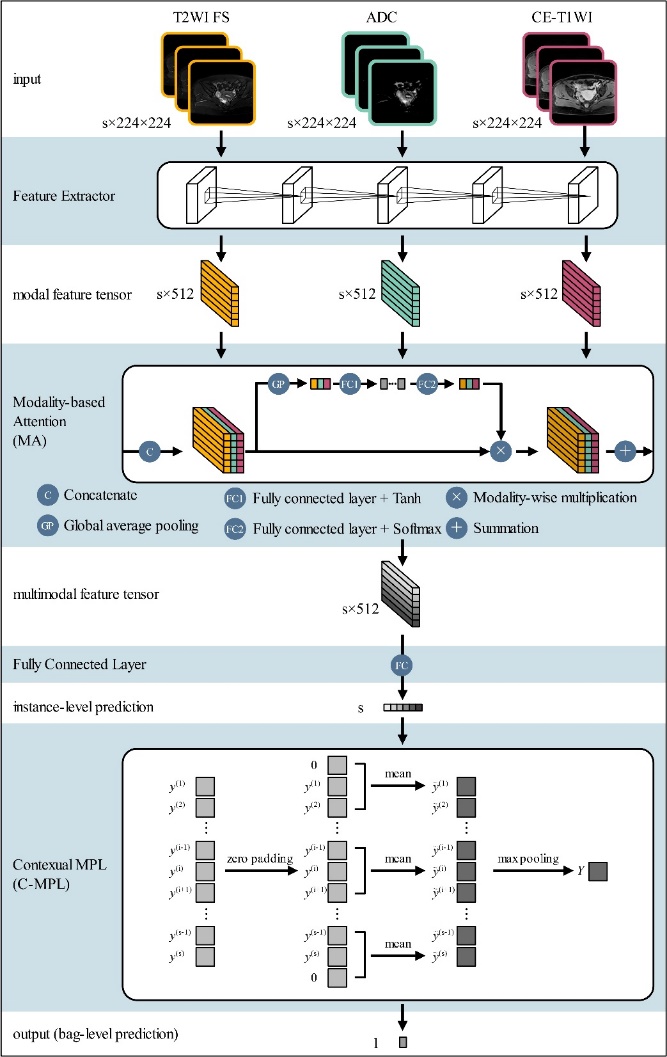A group of scientists at the Suzhou Institute of Biomedical Engineering and Technology (SIBET) of the Chinese Academy of Sciences proposed a new method with MAC-Net to better help preoperative differentiation between BEOTs and MEOTs, two different gynecologic tumors.
The innovative use of MAC-Net, a multiple instance convolutional neural network (MICNN) with modality-based attention (MA) and contextual MIL pooling layer (C-MPL), may overcome shortcomings of existing multimodal intelligence medical image-based diagnosis methods.
The MA module can learn from the decision-making patterns of clinicians to automatically perceive the importance of different MRI modalities and achieve multimodal MRI feature fusion based on their importance, according to Dr. JIAN Junming, one of the leading scientists of the research, at the SIBET.
The C-MPL module uses strong prior knowledge of tumor distribution as an important reference and assesses contextual information between adjacent images, thus achieving a more accurate prediction.
“The performance of MAC-Net is superior, with an area under the receiver operating characteristic curve of 0.878, surpassing that of several known MICNN approaches,” said GAO Xin, who led the research team.
Malignant epithelial ovarian tumors (MEOTs) are the most lethal gynecologic malignancies, accounting for 90% of ovarian cancer cases. In contrast, borderline epithelial ovarian tumors (BEOTs) have low malignant potential and no stromal invasion. BEOTs are prone to have better prognoses than MEOTs with a 5-year survival rate of 92% than 35% of the latter.
BEOT patients can undergo conservative treatment to preserve fertility and ovarian function, while MEOT patients require thorough surgical staging and subsequent adjuvant chemotherapy.
Therefore, accurate preoperative differentiation between BEOTs and MEOTs is crucial for determining the appropriate treatment strategies and improving the postoperative quality of life.
At present, the preoperative differentiation between BEOTs and MEOTs is mainly determined by radiologists using multiparametric MRI images.
“This method relies high on experience, is subjective, time-consuming, and has a relatively low accuracy ranging from 74% to 89%,” said JIAN.
With this method, automatic diagnosis can be achieved without the accurate tumor boundary, but only with the determination of the top and bottom position of the tumor, thus making it more intelligent.
MAC-Net exhibits strong Image adaptability and disease adaptability. MAC-Net can not only be used for multiparametric MRI fusion, but also be extended to multimodal image (such as CT, PET, etc.) fusion. It is not only suitable for ovarian cancer, but can also be used in the automatic diagnosis of solid tumors such as lung cancer, liver cancer, bowel cancer, breast cancer, and prostate cancer.
This research was funded by the National Natural Science Foundation of China and other institutions, related results were published in Artificial Intelligence In Medicine with the title of "Multiple instance convolutional neural network with modality-based attention and contextual multi-instance learning pooling layer for effective differentiation between borderline and malignant epithelial ovarian tumors".

Fig.1. Architecture of MAC-Net. (Image by SIBET)
Contact
XIAO Xintong
Suzhou Institute of Biomedical Engineering and Technology, Chinese Academy of Sciences (http://www.sibet.cas.cn/)
Phone: 86-512-69588013
E-mail: xiaoxt@sibet.ac.cn